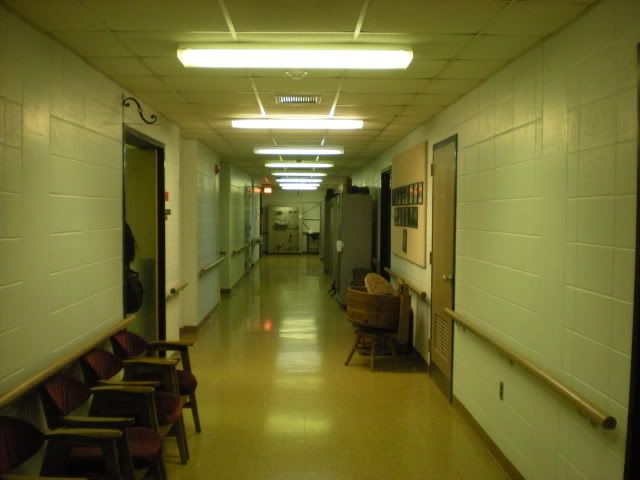
The Glore Psychiatric Museum started as the collection of George Glore, who worked for the Missouri Department of Mental Health and St Joseph State Hospital from 1956-1996. Originally called State Lunatic Asylum #2 when it opened in 1874, and then State Hospital #2, it became St Joseph State Hospital in 1952. The museum is housed in a building that was once the admitting ward and hospital, and services for the mentally ill are now provided across the street at Northwest Missouri Psychiatric Rehabilitation Center.
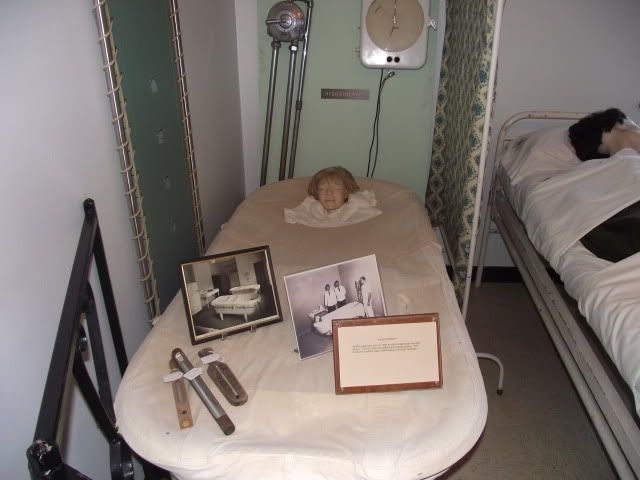
Above is a depiction of hydrotherapy, which was just a warm bath used to calm agitated patients. This practice is not really used anymore since we have drugs that are more effective than trapping a person in a bathtub. Sidenote: the glamour mannequins used in these displays were donated to the museum by a department store. It is, to say the least, startling to round the corners in this museum.
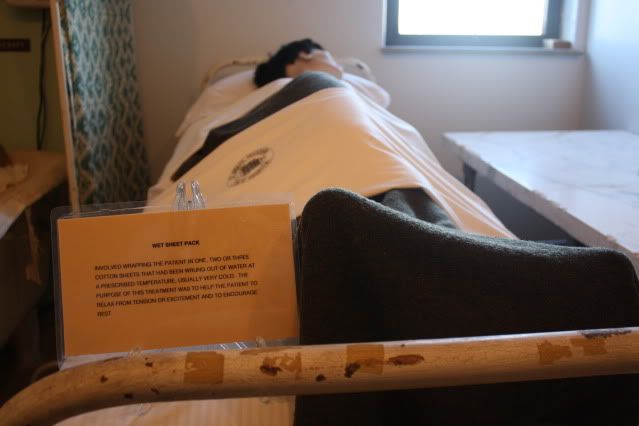
Likewise, a wet sheet pack (usually using cold water) served the same purpose. According to the dedication plaque at the entrance, the purpose of George Glore's collection is to explain how the treatment of mental illness has improved, and to educate through the experiences of mental patients. The thing to remember here is that, while some of these things seem horrifying or barbaric to us now, they really were doing the best they could with the information available at the time.
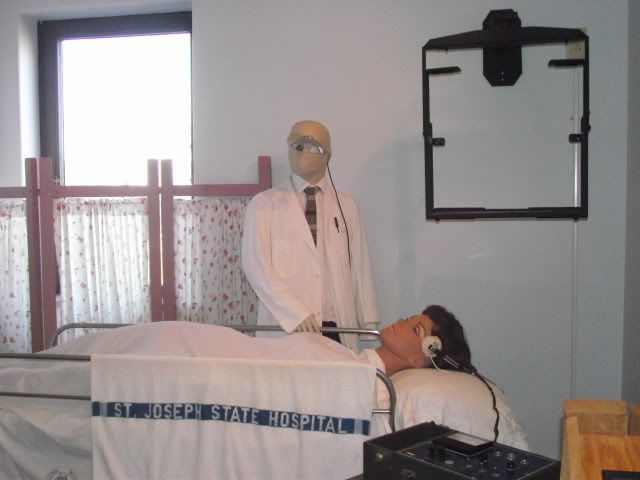
Above is a depiction of insulin shock treatment, which was used to treat schizophrenia. It was a long and dangerous process that basically only had the benefit of making the patient more relaxed afterward and slightly more cooperative with psychotherapy. The "Golden Rule" posted elsewhere in the building says, "Do unto others as you would be done by. No one is immune from mental disease. Any employee of this hospital may, by a freak of fate, become a patient. Let your care of patients be what you would desire for yourself, or any member of your family, if mentally ill." This is from the 1931 Employee Handbook for State Hospital #2. Kind of surprising, isn't it? Like I said, they did the best they could.

St Joseph State Hospital also treated people with syphilis. Above and below are exterior and interior photos of a fever cabinet, or hot box. As you can see in the picture below, the inside of a fever cabinet is covered in light bulbs and mirrors that raise the interior temperature to 105 degrees. A similar treatment using malaria was also used back then. The idea here was that inducing fever would kill the spirochete (bacteria) that causes syphilis. It worked, but the treatment could be more dangerous than the disease itself. Today, syphilis is cured with penicillin.
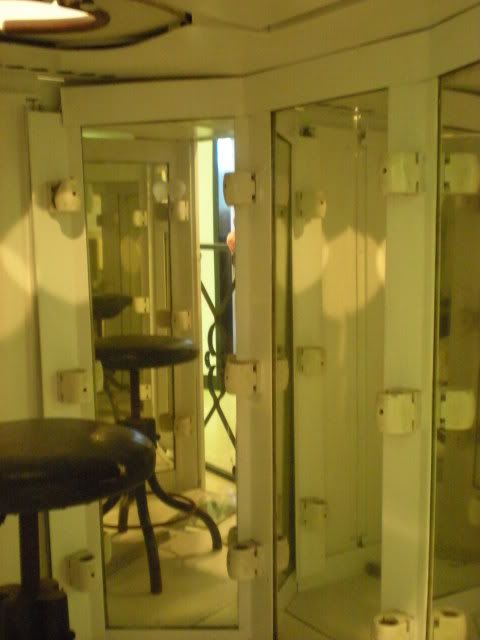
As mentioned at the beginning, this building was once the hospital/clinic for the State Hospital. They had a dentist and ophthalmologist, x-ray lab, occupational therapy, surgery, and a morgue. One of my favorite displays was the story of the EEG machine.

The EEG machine was purchased in 1960, but the two staff psychiatrists at the time had different ideas on how it should be used and were constantly fighting. One hid the machine from the other, and both had left the hospital by 1964. When they hired a new EEG technician, the first order of business was to search the whole hospital to find the machine. They finally found it in a seldom-used storage room, and then State Hospital #2 had the only EEG lab in what seems to be a tri-state area (the display names St Louis, Kansas City, Topeka, and Omaha in a way that doesn't make a lot of sense.)
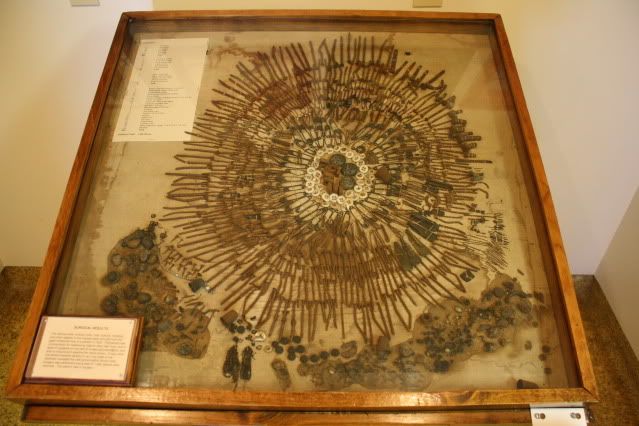
This is an artistic display, artist unknown, of 1,446 items found in the stomach of a woman who suffered from compulsive swallowing of non-food objects. Items removed included 453 nails, 42 screws, 9 bolts, 7 broken coat racks hooks, 5 thimbles, 3 salt shaker tops, 105 hair pins, 115 safety pins, 52 carpet tacks, and 37 needles. Sadly, she died in surgery when they tried to remove them.
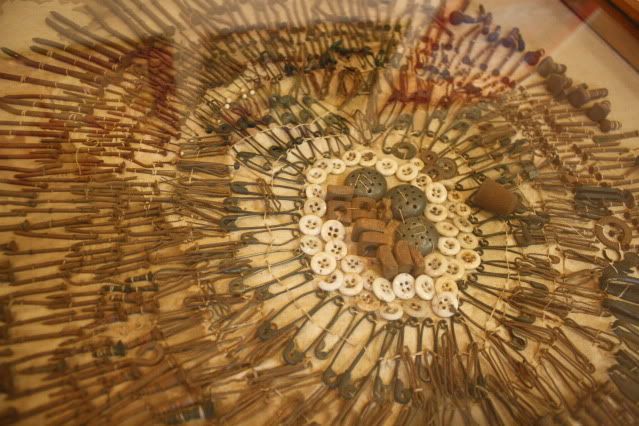
The museum started in 1968 when George Glore worked with hospital carpenters and patients to create an exhibit for Mental Health Awareness Week, creating full size replicas of mental health treatments from the 16th, 17th, and 18th centuries. It was such a hit that he was encouraged to expand. These replicas occupy one large room in the current museum.
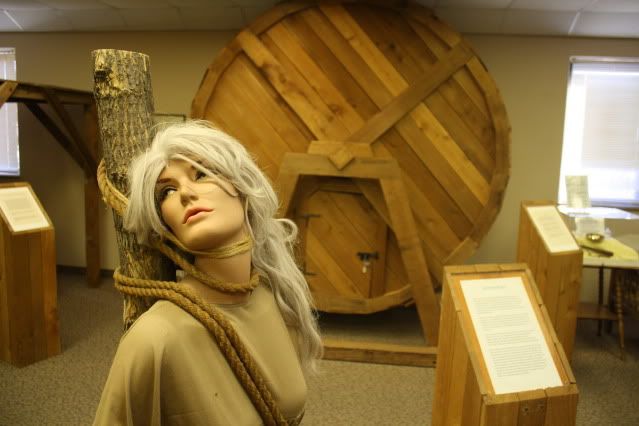
Behind the witch being burned at the stake is the Hollow Wheel from the late 18th century, which was similar to a treadmill, or hamster wheel, and was used to wear out feisty patients. The difference here was that they were locked inside, sometimes for 48 hours at a stretch, and had to either keep moving forward or backward, or stand perfectly still. Any attempt to break out would be thwarted with a good shove of the wheel by the attendant, which would force the patient to keep moving.
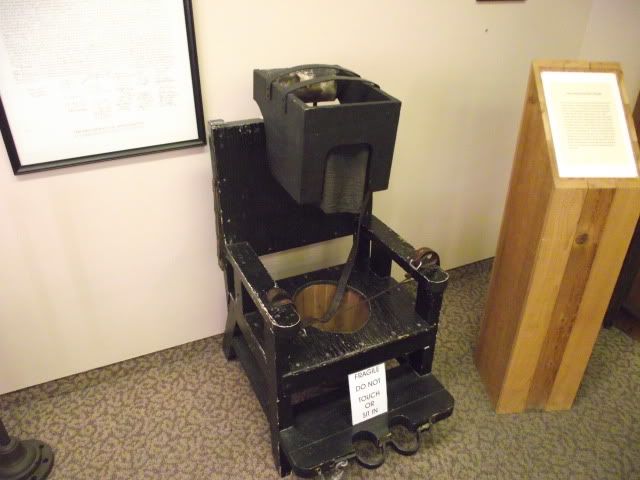
Next we have the tranquilizer chair, invented by Benjamin Rush, in which patients could be imprisoned for up to 6 MONTHS. Dr Rush was a big fan of bleeding - he even had a promotional bleeding knife distributed by a drug manufacturer - and believed that mental disorders were caused by too much blood to the brain. The idea behind this chair was to restrict movement and quiet the pulse.
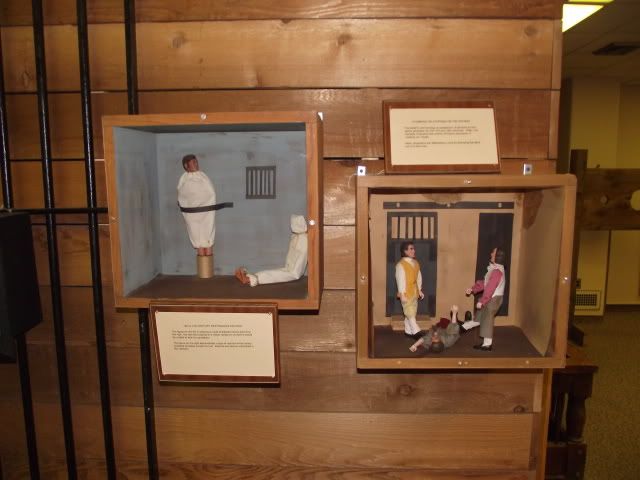
These are dioramas made by a patient. Above left, restraint devices from the 16th and 17th centuries. Above right, physicians "stomping the devil out" of a man. Below left, water dousing or douching, in which cold water was thrown into the face of the patient to shock them to their senses. Below right, bloodletting to release impurities in the blood thought to cause mental disorders.

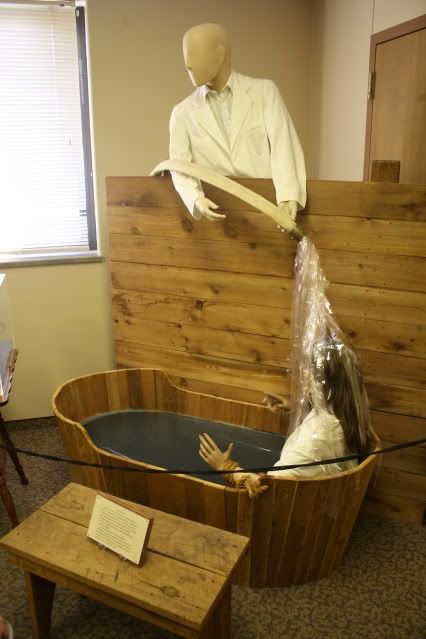
There's a full size replica of the water douching above. And finally, the Bath of Surprise. It's pretty much what you would expect from the name. The patient sat on a trapdoor above the pool, and was dunked without warning. Seems rather labor intensive and cumbersome for an effect that could be accomplished with a bucket.
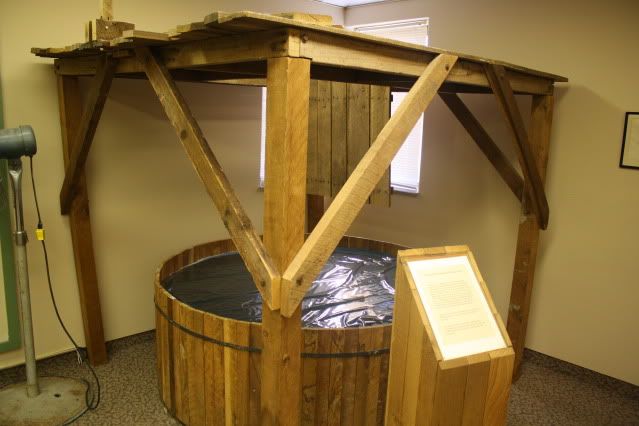
Okay, I think that's enough for one day! Tune in next week when we will talk about what the patients did with their time at St Joseph State Hospital!
Direct Link to Part Two

an official "holy shit" is in order
ReplyDeleteI love this museum! The history of the grounds is just as intriguing as the history inside the museum.
ReplyDeleteVery cool. Man why do I love this kind of stuff, crazy, but awesome post.
ReplyDeleteI agree with Anonymous above. What particularly made me nauseous is the "artistic display" of the 1400 items found in the stomach of the patient.
ReplyDeleteJust went here about a month ago. It was very interesting, sad, fascinating, macabre, and just a great place to go.
ReplyDeleteThis comment has been removed by a blog administrator.
ReplyDeleteThis is a sad reality of how little is known about helping others. Those helping the mentally hurt seem irrational, more-so than the patients. If one were needing help it seems logical to be helpful. Beautiful surroundings, meditation, an organic diet and kindness could be helpful for those that are mentally hurt. I don't understand how anyone could heal in mental health facilities then or now. Love and understanding is a much better start because it leads towards a cure. -RMG
ReplyDeleteI saw on tv there are paranormal activity inside museum, is it true?
ReplyDeleteThis comment has been removed by a blog administrator.
ReplyDeleteThis comment has been removed by a blog administrator.
ReplyDeleteThis comment has been removed by a blog administrator.
ReplyDeleteSitus judi bola online terpercaya
ReplyDeletesitus judi bola online
situs judi bola
agen judi bola online terpercaya
agen judi bola online
agen judi bola
judi bola
situs judi bola resmi
situs judi bola
judi bola online
agen judi bola
judi bola terpercaya
bandar judi bola terbesar di dunia
judi bola 88
kumpulan situs judi bola terpercaya
situs judi bola terbesar
7meter judi bola
situs judi bola terpercaya
agen judi bola terpercaya
judi bola piala dunia 2018
judi bola macau
judi online bola
cara main judi bola
judi bola indonesia
judi bola 365
cara bermain judi bola
cara daftar judi bola
Never seen this kind of useful post. psychiatric treatment clinic
ReplyDeletePelangitoto
ReplyDeletetogel murah
sarana4d
togel
togel hk
Tunai4d
togel singapura
togel Pelangi4d
dewa togel
togel sgp
pengeluaran togel
I see all the pictures you mentioned on your blog. And that really impressed me. You have great knowledge of this. Please share more information with us. Therapist Bakersfield CA
ReplyDeleteI'm very impressed with your ideas that are really amazing. You have good knowledge of this. Keep sharing your things with us.
ReplyDeletePhysiotherapy Clinic in Gold Coast
Thanks allowed me to comment in here, verry informative post, i'm so interesting
ReplyDeleteAlso visit our website in:
judi slot online
situs judi slot
prediksi hk malam ini
Great job for publishing such a nice article. Your article isn’t only useful but it is additionally really informative. Thank you because you have been willing to share information with us. Stem Cell Therapy houston
ReplyDeleteExcellent write-up. I absolutely appreciate this website. 파워볼 하는법
ReplyDeleteJust when I couldn’t love you more. You posted this pic and my jaw dropped to the floor.
ReplyDelete무료야설
립카페
마사지블루
건마탑
온라인카지노
mmorpg oyunlar
ReplyDeleteinstagram takipçi satın al
Tiktok jeton hilesi
TİKTOK JETON HİLESİ
antalya saç ekimi
İnstagram takipçi
instagram takipçi satın al
metin2 pvp serverlar
instagram takipçi satın al
oncasino
ReplyDeletesmm panel
ReplyDeletesmm panel
İş ilanları
instagram takipçi satın al
hirdavatciburada.com
Beyazesyateknikservisi.com.tr
servis
jeton hilesi
awesome post https://emiliowjrp921.tumblr.com/post/685214838538043392/meet-the-steve-jobs-of-the-website-optimization
ReplyDeleteGood content. You write beautiful things.
ReplyDeletemrbahis
mrbahis
sportsbet
vbet
sportsbet
hacklink
korsan taksi
hacklink
taksi
This post is on your page i will follow your new content.
ReplyDeletemrbahis.co
casino siteleri
sportsbet
mrbahis giriş
sportsbet
mrbahis
sportsbetgiris.net
sportsbet giriş
casino siteleri
Izhaar Shayari
ReplyDeleteAnniversary SMS
Life Shayari
Anmol Vachan Shayari
Sharabi SMS
Navratri SMS
Ishq Shayari
Jeoulousy Shayari
TeamViewer Crack
ReplyDeleteAdobe Premiere Pro Crack
WinRAR Crack
4K Video Downloader Crack
Grammarly Crack
Tenorshare ReiBoot Crack
Plagiarism Checker X Crack
Bandicam Crack
CyberGhost VPN Crack
2016 youtube to mp3 reddit
ReplyDeleteyoutube to mp3 converter -- yt3
youtube to mp3 converter high quality free download
www freemake youtube to mp3 boom
youtube convert to mp3 192 kbps
https://yttomp3.pro/
youtube to mp3 latest hindi songs
youtube to mp3 on dropbox
youtube to mp3 converter v 1.7.0.7
download video youtube online to mp3
Most museums are about history or wars but this one is so unique. This is my first time reading about that psychiatric museum. https://www.google.com/maps?cid=4488280802242044319
ReplyDeletemaltepe
ReplyDeleteüsküdar
aksaray
ataşehir
bahçeşehir
X0R6K
salt likit
ReplyDeletesalt likit
15TOG
You've given my profile a fresh vibe with these DP images. Make sure to explore https://imageshack.com/user/dpwalay for more fantastic options!
ReplyDeletehttps://saglamproxy.com
ReplyDeletemetin2 proxy
proxy satın al
knight online proxy
mobil proxy satın al
K7MİH
düzce evden eve nakliyat
ReplyDeletedenizli evden eve nakliyat
kırşehir evden eve nakliyat
çorum evden eve nakliyat
afyon evden eve nakliyat
L6NHK5
8B2AC
ReplyDeleteUşak Evden Eve Nakliyat
Kırşehir Parça Eşya Taşıma
Ordu Şehir İçi Nakliyat
Mersin Evden Eve Nakliyat
Çankırı Lojistik
Adana Parça Eşya Taşıma
Bibox Güvenilir mi
Gümüşhane Şehirler Arası Nakliyat
Erzurum Şehirler Arası Nakliyat
84E7B
ReplyDeleteorder peptides
Çerkezköy Buzdolabı Tamircisi
Antalya Lojistik
Niğde Şehir İçi Nakliyat
buy oxandrolone anavar
Manisa Lojistik
Artvin Lojistik
Urfa Evden Eve Nakliyat
Niğde Evden Eve Nakliyat
48528
ReplyDeleteDüzce Şehir İçi Nakliyat
Şırnak Lojistik
Bitmex Güvenilir mi
Aksaray Şehirler Arası Nakliyat
Burdur Evden Eve Nakliyat
Ort Coin Hangi Borsada
Coin Nedir
Muş Parça Eşya Taşıma
Ünye Oto Elektrik
2CCC8
ReplyDeleteBitcoin Madenciliği Nedir
Coin Çıkarma Siteleri
Coin Para Kazanma
Bitcoin Nedir
resimli magnet
Kripto Para Oynama
resimli
Coin Madenciliği Nasıl Yapılır
Binance Nasıl Üye Olunur
3DD9D
ReplyDeletereferans kimliği nedir
resimli magnet
binance referans kodu
binance referans kodu
resimli magnet
binance referans kodu
referans kimliği nedir
resimli magnet
binance referans kodu
FD0F3
ReplyDeletebinance
telegram kripto para
canlı sohbet ucretsiz
probit
binance referans kimliği nedir
bitget
probit
gate io
4g mobil
46667
ReplyDeletereferans kodu binance
kraken
en eski kripto borsası
en güvenilir kripto borsası
türk kripto telegram grupları
kripto para nereden alınır
papaya
btcturk
kripto ne demek